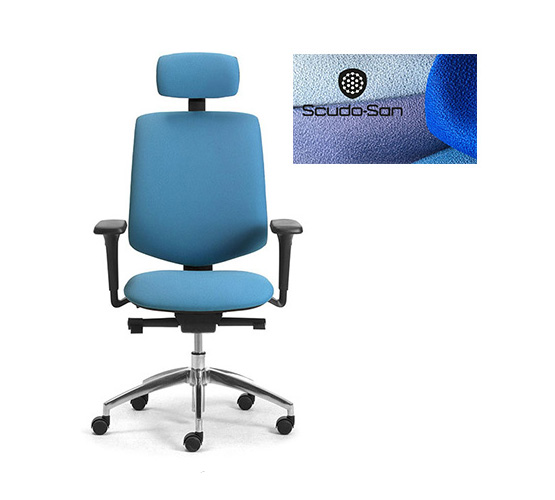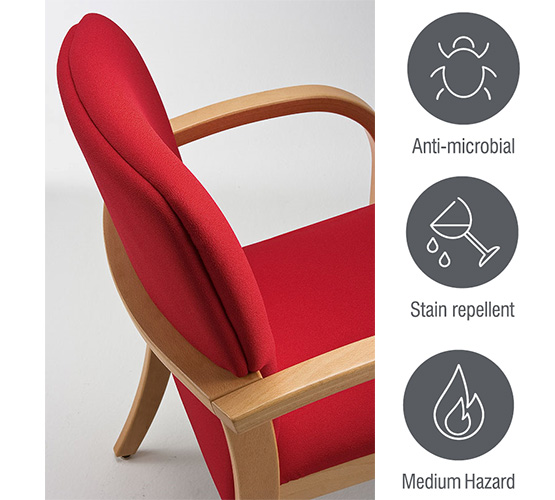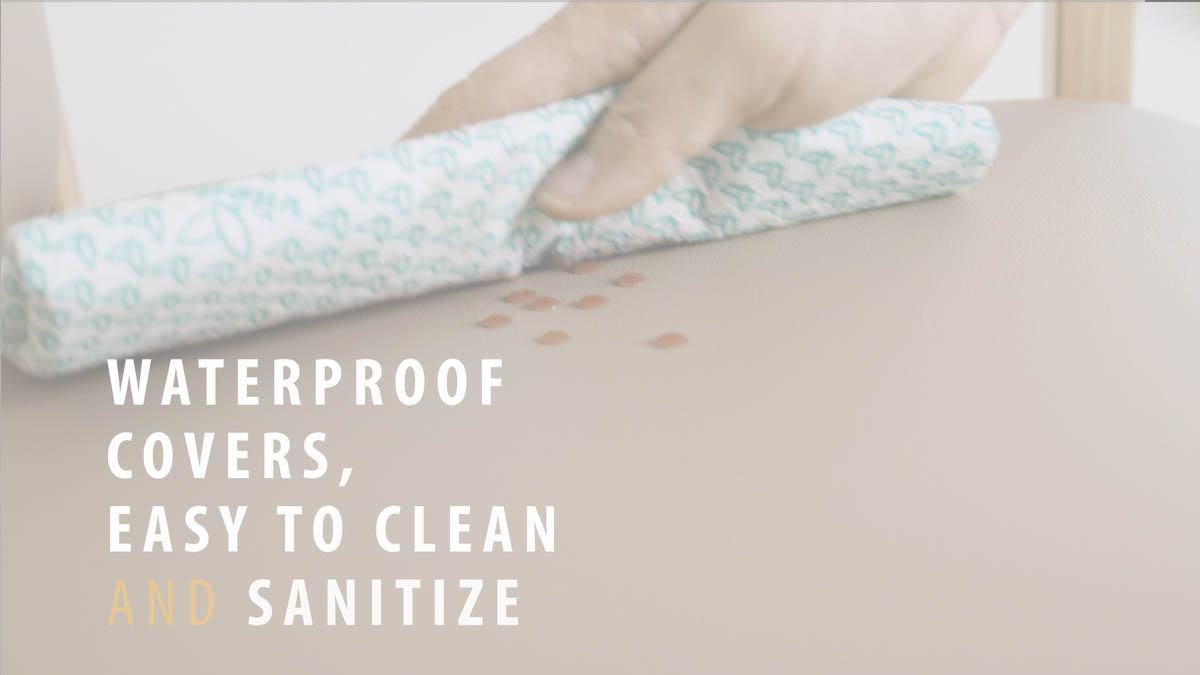COVERS WITH ANTI-MICROBIAL AND ANTI-STAIN TREATMENT DESIGNED TO PROMOTE SANITATION
CHAIRS COVERED WITH ANTIBACTERIAL AND STAIN-RESISTANT FABRIC
Chairs and armchairs that adopt antibacterial and stain-resistant silver-based covers designed to promote hygiene and safety
Nowadays it is essential for a fabric intended for home, office, community and waiting furniture to offer not only comfort and fire resistance but also freshness, breathability and hygiene.Fabrics with Leyform's SCUDOSAN Global Active Protection treatment are treated with silver microparticles that provide antibacterial and antimicrobial protection. Read more...
Medical uses of silver include its incorporation into wound gauze, creams, and as a germicidal coating in medical devices. Silver's antimicrobial action has been known since ancient times; in fact, active silver ions fight the growth of bacteria by blocking the enzymes that carry the oxygen necessary for their proliferation within tissues.
ACTIVE, TASK CHAIR WITH ANTIBACTERIAL FABRICS
Office task chairs with antibacterial upholstery
Man has relied on silver for centuries - not only as a material for jewelry or everyday items - especially for its bacteriostatic effect. For example, at the beginning of the modern age (1500 - 1800), milk was stored using silver coins. Today, silver is used as an effective bacteriostatic agent in the most diverse fields, such as cosmetics or medicine. Modern medical technologies are unthinkable without silver; the SCUDO-SAN technology adopted by Leyform in the upholstery of Active seats provides hygienic and fresh effects with water-repellent and anti-machia characteristics for the seat. The silver ion technology found in Leyform's SCUDOSAN upholstery enables the blocking of oxygen-carrying enzymes and the deactivation of sulfur-containing proteins of odor-causing bacteria.
Discover fabric chartANTIMICROBIAL VINYL THAT CAN BE SANITIZED WITH BLEACH
Chairs and armchairs upholstered with antimicrobial vinyls that can be washed with bleach diluted in water at a ratio of 1:4 to fight virus transmission
Covid-19 has caused worldwide havoc and highlighted the issues of hygiene and sanitation in public and residential environments. While it's impossible to apply social distance to the chairs and furniture we sit on, what we can do is make the faux leather used to cover seat cushions safer and easier to clean as far as infection control and transmission is concerned. For quick disinfection, Leyform has a wide range of synthetic upholstery that can be washed with bleach diluted in water at a ratio of 1:4. Read more...
In fact, bleach is a very common disinfectant based on sodium hypocolorite - a powerful oxidizing agent that has the property of killing any bacteria or germs it comes into contact with. It is recommended in healthcare cleaning protocols as a quick and effective solution for cleaning upholstery. In order to guarantee the resistance to bleach, the artificial leathers proposed by Leyform to cover its operative, executive, community and waiting seats are tested in specialized laboratories according to the BS EN ISO 105-E03 standard; during the tests the artificial leather is placed in a container with a solution of bleach and water in a ratio of 1:4 and is then treated through a washing cycle of 30 minutes to check the resistance of the color. To be classified as bleach-washable, a fabric cannot fade when exposed to bleach.
KALI, CHAIR FOR SANITARY FIELD COVERED WITH WASHABLE IMITATION LEATHER
Chair for retirement homes, silver age and healthcare enviroments covered with imitation leather that can be sanitized with bleach diluted in water
Leyform uses artificial leather that can be easily cleaned and sanitized with bleach using a chlorine solution at a ratio of up to 1:4. In particular it is good to follow the recommendations on the brand of bleach used for sanitizing the covers in relation to the amount of water needed; for sanitizing it is good to soak a cotton cloth, wring out the excess liquid and gently clean the fake leather leaving it to dry naturally. In addition to this it is good to continue to apply the same basic principles for the care and maintenance of upholstery, namely:
- frequently vacuum the upholstery of the seat, backrest and under seat
- Intervene quickly on stains with a damp cloth using neutral soap.
The Active and Kali seats adopt different and parallel strategies to combat the proliferation of viruses and bacteria; the adoption of SCUDOSAN technology in the spun upholstery uses silver to hinder the transmission of viruses and bacteria while the bleach-washable mock leathers, thanks to the antibacterial characteristics of the sodium hypocolorite present in this powerful detergent, ensure safer and more incisive sanitization in hospitals, nursing homes, medical clinics and healthcare environments in general. Read more...
- Fabrics with SCUDOSAN treatment with Global Active Protection are formed with silver microparticles that provide antibacterial, stain and antimicrobial protection.
- The active silver ions in Leyform's SCUDOSAN treated yarns fight the growth of bacteria by blocking the enzymes that carry the oxygen necessary for their proliferation within the fabric.
- The use of synthetic leathers that can be sanitized with bleach diluted in water at a ratio of 1:4 makes Leyform seat padding safer and easier to clean with regard to the transmission of viruses, bacteria and infection control.
- Washable eco-leather with bleach - which is a very common disinfectant made from sodium hypocolorite - diluted in water allows it to kill any bacteria or germs it comes into contact with.
- Bleach is made from sodium hypochlorite and belongs to a class of chemicals known as oxidizing agents, which means that they cause a chemical reaction called oxidation when they come into contact with stains, germs or other organisms by oxidizing their molecules and thus killing them.



